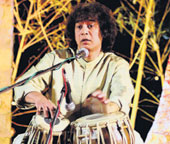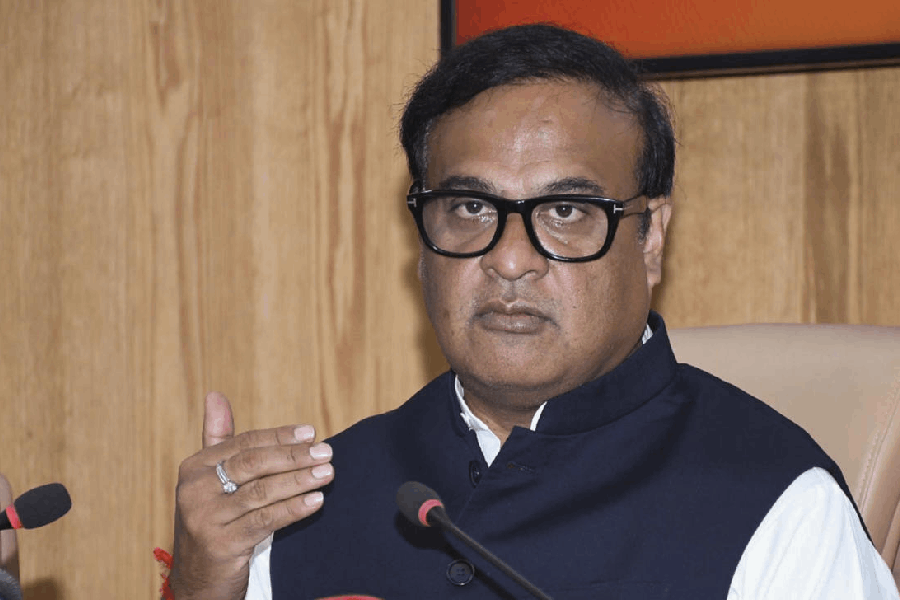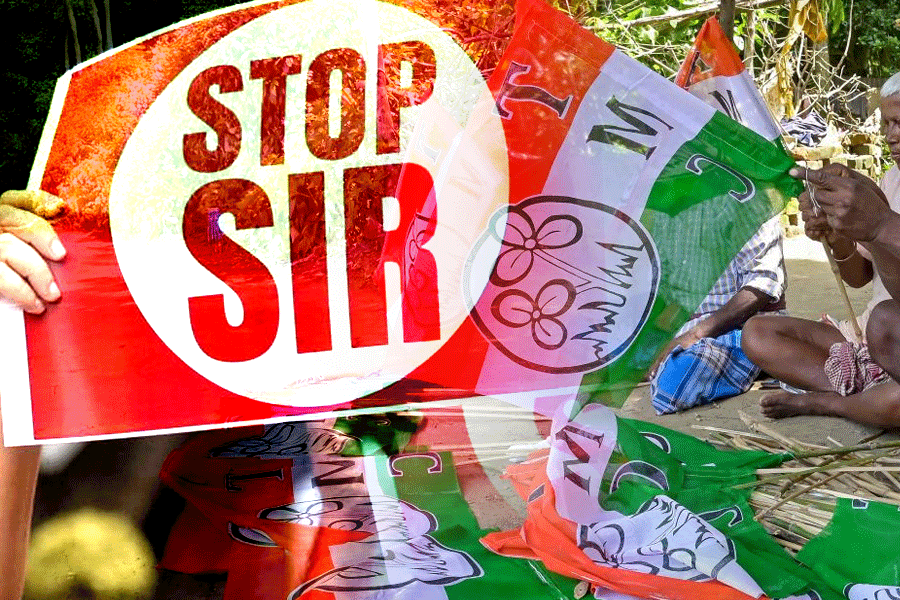 |
| MAGIC FINGERS: Ustad Zakir Hussain |
This was one sawaal-jawaab that went sour. One jugalbandi of titans that ended, not with a bang, but with a bad taste in the mouth. On February 11, sitar legend Pandit Ravi Shankar and tabla virtuoso Ustad Zakir Hussain, two of the greatest names in Indian classical music, were to have wrought collective magic at Mumbai’s Shanmukhananda Hall. What happened, though, was an unseemly incident in which Hussain, upset with the volume of his microphone ? he felt it was too low ? took it off its stand and continued playing without audio support.
But the audience wanted to hear the flamboyant, tousle-haired tabla genius play. So the mike was replaced, the show went on, and later, an irate Ravi Shankar tut-tutted that it was customary to have the sound of the accompanist 20 per cent lower than the volume of his sitar and that Hussain’s outburst was completely “unjustified”.
But was it? While virtually no one from the Indian classical music fraternity will stick his neck out and say what really lay behind the incident ? was it merely a technical glitch, or had Hussain’s microphone been deliberately kept at a lower pitch than usual? ? the controversy does throw up some key questions regarding the role of the tabla player in a modern day classical music concert. Must he, for instance, always play second fiddle to the “main” musician? Must he be muted and low key, his wizardry on the drums never to equal or outshine the artistry of the instrumentalist? Or can he claim equal space with the sitarist or the sarodist whom he accompanies?
After all, the tabla as a musical instrument is phenomenally popular today. From rock to jazz to fusion, its beat is ubiquitous, invading the mindspace of people the world over. As noted tabla player Bikram Ghosh, who made his bones playing with the likes of Ravi Shankar, points out, “The tabla player today is a star. The audience wishes to see as much of him as the instrumentalist.” So then should a Zakir Hussain, who is a mega celebrity in his own right and often considered the prime mover of the tabla’s worldwide popularity, have to assume a subdued role when he is accompanying a Ravi Shankar?
“Two maestros conflicting over volume levels is nothing new,” says Ghosh. Indeed, any tabaliya will tell you that while it’s standard practice to keep the volume of the accompanist somewhat lower than that of the instrumentalist, they have often been in situations when it was kept much lower than what was desirable.
Veteran tabla artiste Anindya Chatterjee, for instance, remembers playing with a sitar great at the Royal Festival Hall in London in 1991-92 when his tabla could be barely heard in the auditorium. So much so that during the interval the audience sent out notes, requesting that the volume of his microphone be raised.
“Of course, this could be due to a purely technical mismatch,” admits Kumar Bose, another widely respected tabla player, “but yes, it sometimes happens that the main musician wants to dominate the show and pushes for a less than ideal volume level for accompanists.”
Part of the reason for that is, of course, a mindset that’s a throwback to the old days when accompanists used to be several notches down the pecking order of musicians. “Vocalists, instrumentalists and tabla players followed in that order of importance,” says Ghosh. Accompanists were often in the employ of vocalists and, therefore, had a socially inferior position as well. “Kesarbai Kelkar and Hirabai Barodkar had permanent instrumentalists attached to them,” points out Vijay Kichlu, a classical vocalist and one of the architects of the Sangeet Research Academy in Calcutta .
The hierarchical set up was evident on stage too, for there was a time ? even up to some decades ago ? when the accompanists sat somewhat behind the vocalist or the main instrumentalist.
But all that is history now. Just as the tabaliya has moved upstage physically, the tabla’s popularity, helped along by the work of such maestros as Kishan Maharaj, Alla Rakha and Samtaprasad, and, of course, Zakir Hussain himself, has also gone mainstream.
Ironically, Ravi Shankar himself did a lot to popularise the tabla. “He belongs to the Maihar gharana, where there is a more active rhythmic interplay with the tabla and he was always known to encourage his accompanists,” says Kichlu. But it was also Shankar who had once rebuked the audience when it clapped after a vigorous tabla flourish, “Sum pe aane se taali kyun bajate hain, yeh koi football ka goal nahin hai!”
Yet the conversation between the instrumentalist and the sangatkar, the dextrous machismo of a tehai or the playful banter of a sawaal-jawaab, happens to be the most entertaining part of a concert for the majority of the audience. “The tabla is very audience friendly,” admits Aman Ali Khan, son of sarod maestro Amjad Ali Khan, who had none other than Zakir Hussain doing his sangatkari on his maiden concert. “But I don’t have a problem with that at all,” says Khan with charming simplicity. “My job is to provide the melody. His job is to give the rhythm. I see it this way ? if you are good, the audience will follow you.”
Indeed, most instrumentalists acknowledge the fact that the tabla is riding high on the popularity charts. “Arre bhai, why not?” says sitarist Shujaat Khan, son of another sitar legend, the late Ustad Vilayat Khan, “After all, the sitar, the sarod, the santoor, they all began as accompaniments. If they could move mainstream, why not the tabla?” Khan also feels that in the last 30 years, the tabla player’s “investment in his art” has gone up tremendously. “Given that, he deserves to have a greater involvement in the concert,” he says.
But what should be the extent of this involvement? “It’s a mix that cannot be quantified,” says Kumar Bose. “Basically, neither should try and overshadow the other and the music they make together should be aesthetic and pleasing to the audience.” Agrees Kichlu, “It is a fact that the main musician controls the music, but as far as the audience is concerned, they are on a par. The role of the tabla player is now as important as the role of the instrumentalist.”
Perhaps. But that’s an ideal that does not always come to pass. Shujaat Khan, for instance, is quite candid about the shifting power equations between an instrumentalist and his accompanist. “If you play with a senior artiste like Zakirbhai, you have to be much more respectful of his space than if you are playing with a junior artiste. Basically, I think you should only play with people you are comfortable with.”
Evidently, it’s a dictum that holds true as much for lesser-known musicians as for international superstars like Zakir Hussain and Ravi Shankar.










